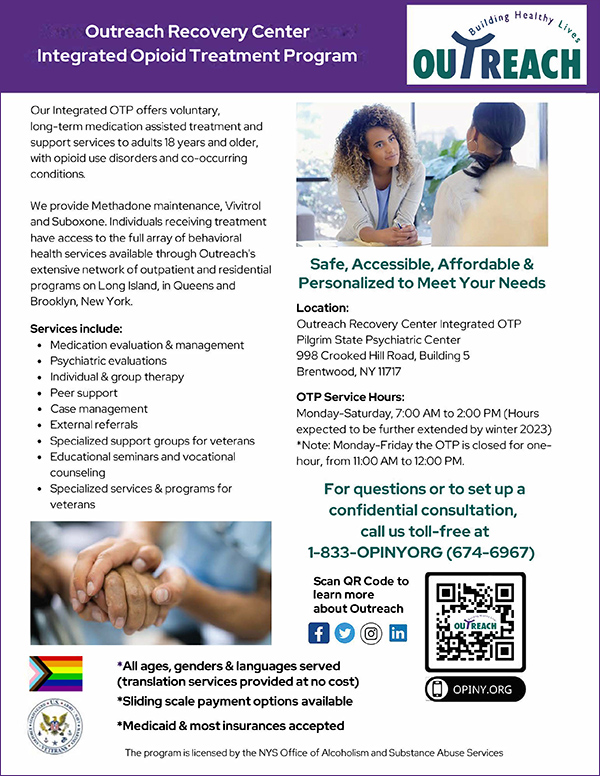The opioid epidemic has impacted our families, friends, and communities. The New York State Office of Addiction Services and Supports (OASAS) estimates that 1 in 13 New York State residents suffer from a substance abuse disorder.1 Among NYS residents, the number of overdose deaths involving any opioid increased 294 percent from 2010 to 2020.2

The rise in unintentional opioid overdose (both fatal and non-fatal) has clearly shown that treatment options to address opioid and substance use disorders need to be more accessible in our communities. The lack of treatment options to address the opioid epidemic is detrimental to individuals who have entered the contemplation and planning stages of change. The individual seeking change should have the ability to choose from all types of treatment options, including the variety of medications used to treat opioid and substance use disorders. Treatment options for addiction have not been adequate when compared to treatment options for other diseases.
Methadone was first approved for the treatment of OUD in the 1970s. Research conducted in the years since its approval has reinforced methadone’s safety and effectiveness in reducing overdose deaths, illicit opioid use, and the transmission of infectious diseases such as hepatitis C and HIV – while improving retention in care compared with treatment without medication.3
Although providers and clients have lists of resources and treatment programs throughout the state, accessible Opioid Treatment Programs remain scarce in many areas. SAMHSA’s opioid treatment program directory lists only 139 OTPs in the state of New York.4 This is not sufficient for a state with a population that is estimated to be 19, 677,151.5
On January 17, 2023, we opened our Integrated Opioid Treatment Program at Outreach Recovery Center, located in Brentwood, NY, offering an additional methadone maintenance program for our community. Since its opening, we have been able to mitigate waiting lists and offer individuals easier access to this level of care. We have been able to prevent individuals from having to spend the entirety of their day commuting to a location up to 50 miles away from their living area. Having an OTP central to one’s residence allows individuals to also address other priorities such as family responsibilities, self-help, and employment.
As it is common for individuals with a history of addiction to not address their health needs, we are assisting and referring clients to appropriate medical and wound care, while providing harm reduction and psychoeducation regarding opioid overdose prevention to individuals and their families. This includes Narcan training, fentanyl and xylazine testing strips, as well as safety planning that individuals can utilize during high-risk situations. While providing lifesaving medication, we also offer additional services such as counseling, case management, peer, and vocational services. Additional referrals to housing and transportation services are offered and provided as well. As individuals are exposed to more resources and support, they have the option to increase their involvement in treatment. It is extremely beneficial that they are already established in a program and these additional services can be immediately included into their treatment plan.
Creating OTPs within our communities in greater numbers will reduce the stigma, much like the urgent cares centers we are now seeing on every corner. Using a person-centered approach, clinics can be designed to be warm and welcoming. We have seen a positive response to replacing the stereotypical line with comfortable waiting rooms and a private window for dosing. Staff trained in trauma-informed care and utilizing evidence-based practices such as Cognitive Behavioral Therapy and Motivational Interviewing enhance client engagement. Utilizing translation services can also expand services to many more individuals in need. For individuals who are unable to attend on-site treatment sessions, they have the option to attend individual and group counseling as well as psychiatric services with the use of technology and telehealth appointments. Mitigating such barriers contributes to maintaining client retention.
We have heard time and again from individuals receiving services at our OTP that this accessible service has changed their lives. The need to open more OTPs in our communities is essential in combatting the opioid epidemic. If we continue to have waiting lists for opioid treatment, we will continue to lose individuals that may have otherwise been integral in our society. We see firsthand that OTPs work, and we must continue our push to increase access to care for those who prefer this treatment modality.
Thomas Olivo, LCSW, is Director of the Outpatient Integrated Treatment Program, at Outreach Recovery Center in Brentwood, NY. Website: opiny.org, Email: Thomasolivo@opiny.org, Phone: (631) 521-8400 ext. 5179.
References
- Priority Area: Mental Health/Substance Abuse (ny.gov)
- NY Dept. of Health-Opioid Health Annual Data Report National Center for Health Statistics. Multiple Cause of Death 1999-2020 on CDC WONDER Online Database
- Federal Register: 37 Fed. Reg. 26701 (Dec. 15, 1972) 37; Substance Abuse and Mental Health Services Administration, “Advisory: An Introduction to Extended-Release Injectable Naltrexone for the Treatment of People With Opioid Dependence” (2012) ; Substance Abuse and Mental Health Services Administration, “Medications for Opioid Use Disorder: For Healthcare and Addiction Professionals, Policymakers, Patients, and Families” (2020)
- https://dpt2.samhsa.gov/treatment/directory.aspx
- https://www.census.gov/








